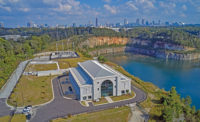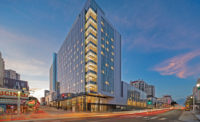Southeast Project of the Year - Grandview Medical Center
Grandview Medical Center, ENR Southeast’s Project of the Year, is a construction comeback story

The Birmingham health-care facility stood unfinished and unused for roughly a decade before a new owner sought to repurpose the structure.
PHOTO BY ANDY COLLIGNON, COMMUNITY HEALTH SYSTEMS

Contractors “retrocommissioned” the facility to determine if previously installed systems could be used in the new hospital, ensuring the project met current-day standards as well as user expectations.
PHOTO BY KIERAN REYNOLDS PHOTOGRAPHY

Contractors “retrocommissioned” the facility to determine if previously installed systems could be used in the new hospital, ensuring the project met current-day standards as well as user expectations.
PHOTO BY KIERAN REYNOLDS PHOTOGRAPHY



Grandview Medical Center
Birmingham, Ala.
Health Care, Best Project
Key Players
Owner Community Health Systems
Lead Design Firm Earl Swensson Associates
General Contractor Brasfield & Gorrie
Civil Engineer Walter Schoel Engineering
Structural Engineer Structural Design Group
Had Grandview Medical Center in Birmingham, Ala., been completed in the early 2000s as originally planned, it might well have won recognition as a “hospital of the future” due to its wireless and Internet-based operations technologies, considered advanced for the time. Instead, the 1-million-sq-ft, 13-story building remained unfinished and sat idly for roughly a decade, a victim of legal issues that ensnarled the previous owner, Health South.
It wasn’t until 2013 that Community Health Systems acquired the giant, dormant structure, eventually launching a combined build-out/renovation that culminated in October 2015 with the transfer of nearly 100 patients to the gleaming 372-bed facility.
To help make Grandview’s comeback story a reality, Birmingham-based Brasfield & Gorrie—the original project’s general contractor—was retained to tackle this multifaceted construction time warp.
Uncertainties abounded at the restart, from the condition of the 10-year old building’s shell, to the salvageability of its installed—yet uncommissioned, unwarranted and possibly out-of-date—building systems. Contractors would have to perform interior fit-up work in concert with tear-outs of some finished spaces to accommodate the medical specialties of a tertiary care hospital as well as to satisfy building codes that had changed significantly since 2003.
In addition to the revamped hospital, Brasfield & Gorrie was simultaneously building two adjacent projects—an eight-story, 220,000-sq-ft medical office building and a 1.2-million-sq-ft parking garage. All three projects would factor into the contractor’s planning, scheduling and execution.
Brasfield & Gorrie project director Robert Robison says the original project’s then-advanced incorporation of digital technology proved to be a benefit during reconstruction.
“This was a leading-edge, digital hospital, programmed with features that other hospitals weren’t doing at the time, such as structured cabling,” he says. “Without that, there would’ve been even more challenges.”
One of the first steps in reviving Grandview was one typically saved for near the end. By “retro-commissioning” existing mechanical, electrical and plumbing systems early in the restart phase, contractors confirmed that most installed equipment could serve the repurposed hospital. This process eliminated both uncertainty and potential costs from the project budget.
As construction got underway, the general contractor divided the overall project into what Robison calls “mini jobs”—separate preconstruction and management teams for the hospital’s new build-out and HVAC retrofits, as well as for the parking deck, office building and sitework package. Using Last Planner software helped minimize conflicts and enabled contractors to redirect trade resources to specific areas as needed.
Other new technologies played a role in advancing the hospital’s restart. Project team members used building information modeling to digitize original construction drawings while also providing a base for incorporating programming-related layout and system infrastructure changes developed by lead architect ESA Architects of Nashville. Contractors also used drone-mounted cameras to inspect 250,000 sq ft of the hospital’s decade-old glass and precast skin exterior to identify areas in need of repair.
To be sure, there were headaches to be expected with reviving a project after 10 years, such as finding new subcontractors and replacement vendors for the specific glazing required in order for the office building’s curtain wall to match that of the hospital.
Despite the unusual set of challenges, the hospital and related projects achieved their expected levels of quality, for a total cost of $280 million. And even with the bustling activity of a multiproject site, Brasfield & Gorrie’s team, which numbered more than 900 field employees at one point, completed nearly 1.9 million hours of work with no lost-time incidents.
Drew Mason, Grandview Medical Center’s chief operating officer, considers the hospital’s successful revival an object lesson in persistence and leadership. And while modern construction technology helped bridge the 10-year time gap, he adds that Brasfield & Gorrie’s history with the project was no less important.
“They knew the building like it was their own,” Mason says.
ENR’s Best Projects judges knew the project was a winner; one judge noted the “great work on bring the building back to life,” while another stated: “Using 4D laser scanning and UAVs to document existing conditions was a great innovation” for “a beautiful project.”








